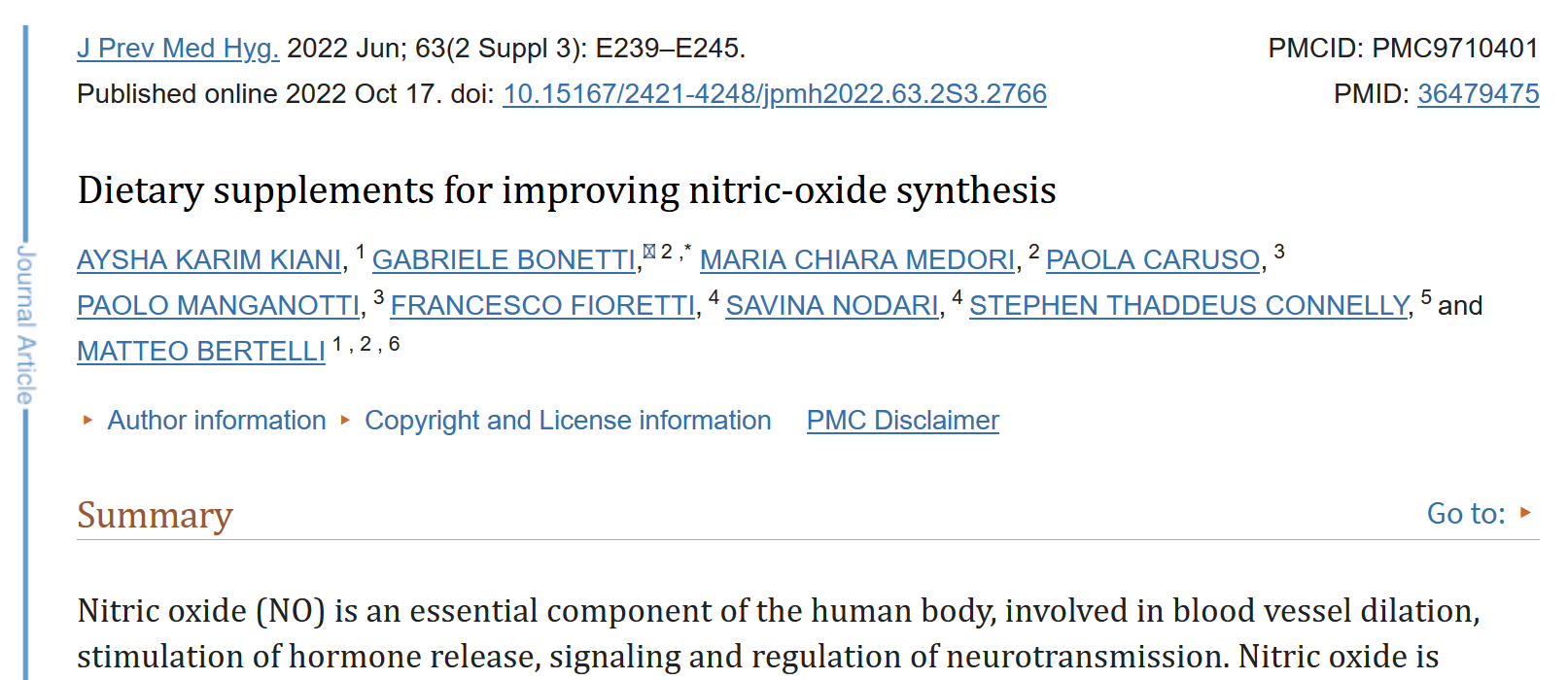 👉 Increase the Blood Flow from the Field of Master Mind Articles (MMA) 📃
👉 Increase the Blood Flow from the Field of Master Mind Articles (MMA) 📃
Shared from the research of: Joseph Mercado 🙆♂️
Content Contributor: PubMed Central 🌏
To: Health Lover 💚
Blog Post #1245 📌
Re: Nitric Oxide 🏃
Date and Time: Monday, January 31, 2022 at 3:59 p.m. ⏰
Dear Health Lover,
Here’s a detailed article about Nitric Oxide…
Summary:
Nitric oxide (NO) is an essential component of the human body, involved in blood vessel dilation, stimulation of hormone release, signaling and regulation of neurotransmission. Nitric oxide is synthesized by nitric-oxide-synthase-dependent and -independent pathways.
Nitric oxide supplementation improves cardiac health, enhances performance during exercise, reduces high blood pressure during pregnancy, reduces erectile dysfunction and improves healing processes and respiratory response. Nitric-oxide-associated benefits are mostly apparent in untrained or moderately trained individuals.
L-arginine and L-citrulline supplementation contributes to nitric oxide levels because L-arginine is directly involved in NO synthesis, whereas L-citrulline acts as an L-arginine precursor that is further converted to NO by a reaction catalyzed by NO synthase.
L-arginine supplements increase respiratory response and enhance performance during exercise, while L-citrulline with malate and other molecules increase working capacity. Various studies involving beetroot juice have reported a significant increase in plasma nitrite levels, regarded as markers of NO, after intake of beetroot juice.
Although NO supplementation may have mild to moderate side-effects, using smaller or divided doses could avoid some of these side-effects. Since nitric oxide supplementation may worsen certain health conditions and may interfere with certain medicines, it should only be taken under medical supervision.
Nitric oxide:
Nitric oxide or nitrogen monoxide (NO) is a component of the human body that may cause dilation of blood vessels and release of hormones such as human growth hormone (GH) and insulin.
Shortly after the role of NO as a signaling molecule was established, it emerged that particular nitric oxide synthases (NOS) catalyze the intricate enzyme reactions that lead to synthesis of NO from the substrates L-arginine and molecular oxygen.
An alternative pathway of NO synthesis, known as NOS-independent, was subsequently discovered: it is based on simple reduction of nitrate and nitrite, major NO oxidation products. Nitric oxide acts as a mediator and regulates significant non-cholinergic and noradrenergic neurotransmission functions involving memory, learning, neuroprotection and synaptic plasticity.
Although nitric oxide supplementation has been used for decades, little scientific evidence is available to support its health benefits.
The composition of NO-stimulating supplements is mostly a cocktail of amino acids, creatine, minerals, carbohydrates, vitamins, and so forth.
Studies have also shown that components like creatine, amino acids and carbohydrates may have ergogenic effects among themselves.
Many studies have used NO-donors and other components like malate, aspartate and glutamate to enhance NO-donor bioavailability.
Benefits associated with NO-donors have been reported in moderately trained individuals, whereas recent scientific data indicates that well-trained athletes benefit less from NO supplements. Hence it appears that the training status of an individual is a significant factor for dietary NO-donor effectiveness.
One logical explanation of the association of exercise with the effectiveness of NO supplementation may be due to the positive effect of physical exercise on the regulation of NO metabolism.
Although short-term physical training promptly increases the bioactivity of NO, if training is continued, the short-term functional changes are followed by NO-dependent structural changes that lead to arterial re-modelling and the structural normalization of shear.
Two of the most prevalent NO supplements are L-arginine and L-citrulline.
Scientists have conducted various clinical trials on the effectiveness and side-effects of NO supplements.
L-arginine:
L-arginine is a metabolically versatile amino acid involved in building proteins and in the synthesis of NO. It is found naturally in dairy products, red meat, fish and poultry. Commercial manufacturers produce it as a pill, cream or powder.
According to a recently published article, a normal person typically consumes almost 5 g L-arginine per day without NO supplementation.
The human body converts consumed L-arginine into NO for different body functions.
Different research studies have reported an increase in exercise performance after consumption of supplements containing L-arginine and other components by moderately trained and untrained subjects.
For example, in their recent study Bailey et al. reported that 6 g/day L-arginine for 3 days with vitamins and other amino acids led to a reduction in VO2 (rate of oxygen consumption) in low to moderate exercise sessions and an extension of exhaustion time (L-arginine: 707-232 seconds; placebo: 562-145 seconds) during the cycling incremental exercise test.
In another study, high-dose L-arginine supplementation (14.2 g/day) was given to females for almost 6 months. At the end of the period, a significant increase in relative maximum power (power/kg), measured as peak jump power in the countermovement jump test, was observed.
Certain male studies show that L-arginine supplements may increase respiratory response. Likewise Koppo et al. showed significantly higher speed in phase II of the VO2 (rate of oxygen consumption) during moderate intensity endurance cycling after 6 g/day L-arginine supplementation for 14 days.
Chen et al. found that L-arginine supplementation 5.2 g/day for 21 days with L-citrulline and antioxidants increased the power output of elderly males by almost 21% during the incremental cycle ergometer exhaustion test.
These results have been associated with an increase in the gas exchange threshold after L-arginine supplementation.
Researchers have also suggested that attenuation of metabolic products like potassium, lactate and ammonia may be caused by increased clearance from the circulation due to NO synthesis and increased blood flow.
Several other studies have also established the benefits of L-arginine supplementation in strength and power performance among moderately-trained individuals.
Campbell reported that L-arginine supplements (6 g/day for 56 days) with a-keto-glutarate significantly increased the value of the one-repetition-maximum bench press test and peak power in a 30-second Wingate anaerobic test.
Stevens and Buford & Koch, measured the acute dose of L-arginine, namely 6 g L-arginine as a-keto-isocaproic supplements, that increases the work sustained in continuous isokinetic eccentric/concentric knee extension repeats and mean power performance during the Wingate anaerobic test for 10 seconds, respectively.
Bailey analysed plasma levels of nitrite and reported a significant increase after L-arginine supplements. In animal models, L-arginine-supplemented diets caused a 1-2% increase in intramuscular concentrations of creatine phosphate, which may lead to increased response in anaerobic exercise.
These results support Buford and Koch’s finding of increased performance during recurrent bouts of anaerobic cycling after taking glycine-arginine-a-ketoisocaproic acid supplements.
L-citrulline:
L-citrulline is a non-essential amino acid found naturally in nuts, meat, watermelon and legumes.
It is manufactured commercially as a powder or pill. In the body, L-citrulline is synthesized by conversion of L-arginine to NO in a NOS-catalyzed reaction.
In healthy populations, normal plasma concentrations of L-citrulline are reported to be almost 25 mmol/L, although lower values were recently measured (10-15 mmol/L) in professional cyclists.
In recent years, dietary interest in L-citrulline has arisen due to its significance as a L-arginine precursor. Interestingly, unlike L-arginine, L-citrulline bypasses hepatic metabolism and is not catalyzed by arginase enzymes.
Physiologists have therefore established that systemic administration of L-citrulline alone could be an efficient way to raise extracellular levels of L-arginine.
Enterocytes take up dietary L-citrulline and release it into the portal circulation, bypassing metabolization by periportal hepatocytes and transporting it to the kidneys where almost 80% is catabolized to L-arginine by proximal tubule cells.
Various studies have analysed the effects of L-citrulline in combination with malate, an intermediate of the tricarboxylic acid cycle. Initial studies calculated adenosine triphosphate (ATP) production rates during finger flexion exercise by 31-phosphorus magnetic resonance spectroscopy.
The results showed that taking 6 g/day L-citrulline with malate for almost 16 days led to a significant increase (almost 34%) in the oxidative production rate of ATP during exercise and a 20% increase in the phosphocreatine recovery rate after exercise.
Lately a research group conducted two studies that showed increased plasma levels of NO metabolites in well-trained athletes at the end of a cycling competition; 2 hours before the race, the athletes had taken a single 6-g dose of L-citrulline with malate.
An increase in the availability of plasma arginine has also been linked to availability of substrate for NO synthesis and to the activity of polymorphonuclear neutrophils.
Another current study by Perez-Guisado and Jakeman confirmed that a single 8-g dose L-citrulline with malate increased working capacity by almost 19%, as measured by the number of repetitions completed until exhaustion in a bench-press fitness test at 80% of one-repetition-maximum.
Nitric oxide synthesis by the NO-synthase-dependent pathway:
The nitric oxide synthase (NOS)-dependent pathway of NO synthesis involves the amino acid L-arginine which participates in a reaction catalyzed by particular NOS enzymes.
Extracellular L-arginine is rapidly taken up by endothelial cells in the presence of molecular oxygen and NADP (nicotinamide adenosine dinucleotide phosphate), and L-arginine is then oxidized to NO [23]. This complex reaction is catalyzed by NOS enzymes containing an L-arginine binding site.
Three nitric oxide synthase isoforms have so far been recognized, including type I or neuronal NOS (nNOS), type II or inducible NOS (iNOS) and type III or endothelial NOS (eNOS).
Both iNOS and eNOS are constitutive enzymes regulated by intracellular calcium/calmodulin, although expression of nNOS may be induced at gene transcription level by aging processes, muscle activity, macrophages and other tissues responding to inflammatory mediators, independent of Ca2+ levels.
L-citrulline may also be considered an alternative NO-donor, because it may bring about an increase in L-arginine levels.
Nitric oxide synthesis by the NO-synthase-independent pathway:
In the 1990s, two distinct research groups discovered a NOS-independent pathway for NO synthesis.
This alternative pathway used nitrate and nitrite as its main precursors.
The NOS-dependent pathway is oxygen dependent, whereas the NOS independent nitrate/nitrite pathway of NO synthesis is activated gradually as oxygen tension falls.
Circulating nitrate has a half-life of almost 5 hours and is distributed to different tissues.
Although the full mechanism is not yet completely defined, various studies have revealed that nitrate circulating in plasma is actively absorbed by salivary glands where its concentration is enhanced in saliva (10 to 20 times higher than in blood).
In the oral cavity, certain facultative anaerobic bacteria that live on the tongue surface reduce this nitrate to nitrite by means of nitrate reductase.
Hence in the absence of oxygen, these anaerobic bacteria utilize nitrate as an alternative electron-acceptor to produce ATP.
After swallowing, half the nitrite present in saliva is transferred to the acidic stomach environment and is metabolized to NO, while the other half remains intact and is reabsorbed to increase circulating concentrations of nitrite in plasma.
Under suitable physiological conditions, this nitrite may be converted into NO and other biologically active nitrogen oxides in the tissues and blood.
These findings establish the presence of a completely reverse/alternative pathway (nitrate–nitrite–NO) in mammals.
Nitrate supplementation:
The alternative NO synthesis pathway has also been well studied with reference to exercise physiology.
Nitrate and nitrite modulate mitochondrial respiration through NO synthesis.
Two recent studies by the same research group showed that plasma NO metabolites like nitrate and nitrite increased significantly after nitrate treatment.
The efficiency of human mitochondria, assessed in vitro by oxygen consumption per molecule of ATP produced (phosphate/oxygen ratio), was significantly enhanced with respect to a placebo group after intake of 0.1 mmol/kg sodium nitrate for 3 days.
Interestingly, studies involving beetroot juice have also reported a significant increase in plasma nitrite levels (regarded as markers of NO) after intake of beetroot juice. Larsen reported it as an alternative metabolic pathway for mitochondrial respiration which might explain the decrease in oxygen demand during exercise after ingestion of nitrate-rich food.
In five other studies by the same research group, nitrate supplementation was taken as beetroot juice and its effects on human performance were assessed. In one of these studies, Bailey reported a significant increase in oxygen uptake kinetics (VO2) after dietary supplementation with nitrate-rich beetroot juice (500 ml/day for 6 days).
Beetroot juice supplements brought about a 19% decrease in pulmonary response amplitude during low to moderate-intensity exercise, such as cycle ergometer.
Beetroot supplementation also caused a 23% decrease with respect to a placebo group in the slow component of VO2 and a 19% extension of exhaustion time in the incremental cycle ergometer test.
The effect of nitrate provided by beetroot juice supplementation was also observed to be faster and acute intake affected cardiovascular response within a few hours.
Vanhatalo validated this effect of beetroot juice supplementation.
They gave a single dose of beetroot juice (500 mL beetroot juice equivalent to 434 mg sodium nitrate) to subjects 2.5 hours prior to a cycle-based ergometer test involving two moderate work-loads with 90% gas exchange threshold, followed by the ramp test.
In another study, Lansley. used the same dose of beetroot juice 2.5 hours prior to exercise and observed significant improvement in mean completion time (2.8%) and average power output (5%) during 4-16.1 km of cycle ergometer time trials, with respect to the placebo group.
Glycine propionyl-L-carnitine:
Glycine propionyl-L-carnitine (GPLC) is a carnitine propionyl ester with an extra glycine.
It is used as a dietary supplement to increase blood levels of nitrate/nitrite which are surrogate markers of NO.
It improves metabolism of NO in two ways: 1) as reported in certain animal studies, the protective action of GPLC is due to its antioxidant properties which may prevent peroxidative damage of vessels.
On this basis, other researchers proposed that reduced release of reactive oxygen species could be associated with lower breakdown of NO; 2) a substantial increase in expression of the eNOS gene was observed in culture medium of human endothelial cells after incubation with carnitine.
Hence, researchers suggested that GPLC could also stimulate NO synthesis through eNOS gene expression.
A number of recent studies have analysed the effect of GPLC as a NO donor in exercise and sport with different conclusions.
Bloomer reported a substantial increase in the plasma metabolites of NO, like nitrate and nitrite, in active male athletes after supplementation with GPLC (4.5 g/day for 4 weeks).
Another study by the same research group further validated these results.
Results obtained by Jacobs et al. revealed that a single dose of GPLC (4.5 g) 90 minutes prior to a performance test, including 5-10-seconds of Wingate sprints on a cycle ergometer separated by active recovery periods of one minute, caused a significant increase in peak power (5.2%) and a decrease in power decrement (5.2%) in sprints, with respect to the placebo group.
2-(Nitroxy) ethyl 2-amino-3- methylbutanoate:
The 2-(nitroxy) ethyl 2-amino-3-methylbutanoate molecule was recently recognized to increase the delivery of NO in the human body and is considered to be more effective and efficient than other traditional NO donors.
A study of the effects of 2-(nitroxy) ethyl 2-amino-3-methylbutanoate on plasma NO markers quantified nitrate/nitrite levels among moderately resistance-trained males.
Several other studies also suggest that NO supplementation increases blood flow in the human body, enhancing individual performance in exercise and sport, and promoting cardiac health, healing and other potential benefits.
Benefits:
Various researchers believe that NO causes body relaxation and widens or dilates the blood vessels.
Improving heart health:
Nitric oxide supplementation has many beneficial and boosting effects on the heart.
These effects include reduction of blood pressure and arterial stiffness and improvement of blood flow in the carotid artery.
However, most of these studies are based on animal models. Further human studies are required to validate these effects of nitric oxide supplementation on the human heart.
Enhancing exercise and recovery:
The significance of NO is quite prominent in exercise physiology and NO supplementation is considered an ergogenic aid. Nitric oxide proves to be a significant blood flow and mitochondrial respiration modulator in physical exercise.
Various researchers have suggested that nitric oxide supplementation could increase oxygen delivery to the muscles.
This could enhance athletic performance and reduce soreness after workouts.
Moreover, genetic variants in several genes, among which nitric oxide synthase 3, the enzyme responsible for NO synthesis, are correlated to endurance performance and trainability.
Several studies published in the journal Sports Medicine suggest that NO supplements may increase exercise tolerance.
However, this effect is more prominent in subjects who exercise at a moderate rate and not regularly.
The studies were mostly conducted on young males and therefore do not predict or offer insights into the effect of NO supplementation on older subjects or women.
It is also proposed that the increase in the blood flow caused by NO synthesis may improve the recovery and healing of activated tissues.
Most commercial NO supplements claim to provide all these benefits and to increase the performance of support related individuals.
Reducing erectile dysfunction:
As NO supplements increases blood flow, they have been studied for erectile dysfunction.
Some published studies show that NO supplementation may reduce erectile dysfunction in mild to moderate cases.
Reducing high blood pressure in pregnancy:
Preeclampsia, also known as gestational hypertension, may endanger both mother and fetus.
In 2005, a study reported that pregnant women who took L-arginine supplements for prolonged periods had lower blood pressure than those who did not.
Although more studies are required to understand these findings, it is a promising result.
Other reported benefits:
There are some further benefits of nitric oxide supplementation.
Research studies have reported that nitric oxide supplementation increases weight loss.
Improvement in lung function was also observed after nitric oxide supplementation in cystic fibrosis patients undergoing treatment for altitude sickness.
Studies conducted on male subjects report remarkable enhancement of respiratory response after L-arginine supplementation.
Koppo observed significant enhancement of speed during phase II of pulmonary oxygen consumption (VO2) at the start of moderately intense endurance exercise after L-arginine supplements (6 g/day for 14 days).
Better recovery was observed after major injury or trauma with nitric oxide supplementation, which also played role in prevention of the common cold.
Nitric oxide supplementation is suggested to reduce the side-effects of memory loss.
Other studies propose that nitric oxide supplementation could help the healing of diabetic foot ulcers.
However, most of these benefits lack scientific support and are generally not based on research. The claims should be properly investigated before accepting or rejecting them.
Side-effects:
Although dietary supplements with L-arginine and L-citrulline are considered safe, they may nevertheless have mild to moderate side-effects, including gastrointestinal disturbances like vomiting, nausea, bloating, diarrhea, stomach pain, as well as headache, heartburn and palpitations.
Tolerance of these amino acids differs greatly between individuals and higher doses (>9 g/day) may increase the risk of gastrointestinal distress.
It is suggested that smaller or divided doses may cause fewer adverse effects.
Existing or prior prosecretory or proabsorptive intestinal states may increase susceptibility.
A secretory intestinal state combined with the extra stimulation of higher doses (> 9 g/day) of L-arginine, L-citrulline or both may overwhelm the capacity of the colon to re-absorb.
Nitric oxide supplementation could have a higher risk of side-effects in persons with certain health conditions.
Such health conditions include cirrhosis, guanidinoacetate methyltransferase deficiency and low blood pressure.
Individuals suffering from liver scarring or cirrhosis should be cautious about taking nitric oxide supplements as they could worsen liver function.
Guanidinoacetate methyltransferase deficiency (GAMT) is a genetic condition associated with lack arginine to creatine converting enzyme.
People with GAMT should therefore not take NO supplements. Persons with low blood pressure should stop nitric oxide supplementation before undergoing any surgery.
Medical practitioners have expressed concern that nitric oxide supplementation could aggravate other health conditions including kidney disease, heart conditions and viral infections such as herpes.
In 2006, a study reported that individuals taking L-arginine after suffering a heart attack were at high risk of gastrointestinal motility, repeated heart attack and hospitalization than heart patients who did not.
Nitric oxide supplements may interfere with certain medications, such as blood pressure and diabetes medication.
Before taking nitric oxide supplements, individuals should consult their health practitioners to avoid side-effects or interference with their medication.
Another interesting fact is that in most research assessing the effect of NO supplementation on athletic performance and during sport or exercise, the amount of nitric oxide obtained from supplements could easily have been obtained from the natural food sources like green leafy vegetables and beetroot juice.
Obtaining nitric oxide from natural food sources is a better option for avoiding certain side-effects.
Conclusions:
Nitric oxide is a physiological compound of the human body that dilates blood vessels, stimulates hormone release, regulates neurotransmission and acts as a signaling molecule.
Nitric oxide is synthesized by NOS-dependent and -independent pathways.
Nitric oxide supplementation improves cardiac health, enhances performance during exercise, improves healing, reduces erectile dysfunction, reduces high blood pressure during pregnancy and improves respiratory response.
The benefits associated with NO have mostly been obtained in moderately trained individuals.
Two prevalent NO supplements are L-arginine and L-citrulline.
L-arginine is involved in NO synthesis. L-arginine supplements increase respiratory response and enhance performance during exercise.
L-citrulline is a L-arginine precursor that is converted into NO by a reaction catalyzed by NOS.
L-citrulline combined with malate and other molecules increase working capacity.
Many studies on beetroot juice report a significant increase in plasma nitrite levels, a NO marker, after intake of beetroot juice.
Similarly, glycine propionyl-L-carnitine and 2-(nitroxy) ethyl 2-amino-3-methylbutanoate are dietary supplements that act as nitric oxide donors, enhance nitric oxide synthesis and may also stimulate NO synthesis through expression of the eNOS gene.
Nitric oxide supplementation may have mild to moderate side-effects including gastrointestinal disturbances like vomiting, nausea, bloating, diarrhea, stomach pain, as well as headache, heartburn and palpitations.
To avoid these side-effects, smaller or divided doses of these supplements are suggested.
Nitric oxide supplements should not be taken by persons with certain health conditions and may interfere with medication.
They should therefore only be taken under medical supervision.
👓 Read the Original Article Here 


 Fly Over to the MMU Facebook Page with Hoot
Fly Over to the MMU Facebook Page with Hoot
 Visit the MMVID Facebook Group Today
Visit the MMVID Facebook Group Today 